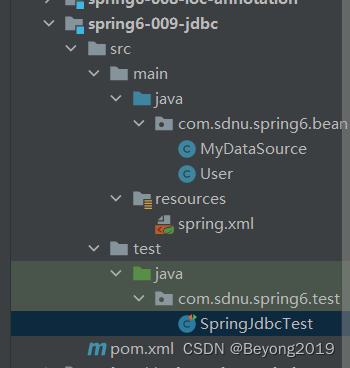1. 环境准备



自己准备的数据源
package com.sdnu.spring6.bean;
import javax.sql.DataSource;
import java.io.PrintWriter;
import java.sql.*;
import java.util.logging.Logger;
/**
* 自己的数据源
*/
public class MyDataSource implements DataSource {
private String driver;
private String url;
private String username;
private String password;
public void setDriver(String driver) {
this.driver = driver;
}
public void setUrl(String url) {
this.url = url;
}
public void setUsername(String username) {
this.username = username;
}
public void setPassword(String password) {
this.password = password;
}
@Override
public Connection getConnection() throws SQLException {
try {
//注册驱动
Class.forName(driver);
//获取数据库连接对象
Connection connection = DriverManager.getConnection(url, username, password);
return connection;
} catch (Exception e) {
e.printStackTrace();
}
return null;
}
@Override
public Connection getConnection(String username, String password) throws SQLException {
return null;
}
@Override
public PrintWriter getLogWriter() throws SQLException {
return null;
}
@Override
public void setLogWriter(PrintWriter out) throws SQLException {
}
@Override
public void setLoginTimeout(int seconds) throws SQLException {
}
@Override
public int getLoginTimeout() throws SQLException {
return 0;
}
@Override
public Logger getParentLogger() throws SQLFeatureNotSupportedException {
return null;
}
@Override
public <T> T unwrap(Class<T> iface) throws SQLException {
return null;
}
@Override
public boolean isWrapperFor(Class<?> iface) throws SQLException {
return false;
}
}
Bean
package com.sdnu.spring6.bean;
public class User {
private Integer id;
private String realName;
private Integer age;
public User() {
}
public User(Integer id, String realName, Integer age) {
this.id = id;
this.realName = realName;
this.age = age;
}
public Integer getId() {
return id;
}
public void setId(Integer id) {
this.id = id;
}
public String getRealName() {
return realName;
}
public void setRealName(String realName) {
this.realName = realName;
}
public Integer getAge() {
return age;
}
public void setAge(Integer age) {
this.age = age;
}
@Override
public String toString() {
return "User{" +
"id=" + id +
", realName='" + realName + '\'' +
", age=" + age +
'}';
}
}
spring配置文件
<?xml version="1.0" encoding="UTF-8"?>
<beans xmlns="http://www.springframework.org/schema/beans"
xmlns:xsi="http://www.w3.org/2001/XMLSchema-instance"
xsi:schemaLocation="http://www.springframework.org/schema/beans http://www.springframework.org/schema/beans/spring-beans.xsd">
<!--配置自己的数据源-->
<!--也可以集成其它组织的数据源,例如druid -->
<bean class="com.sdnu.spring6.bean.MyDataSource" id="ds">
<property name="driver" value="com.mysql.jdbc.Driver"/>
<property name="url" value="jdbc:mysql://localhost:3306/spring6"/>
<property name="username" value="root"/>
<property name="password" value="123456"/>
</bean>
<!--配置jdbcTemplate-->
<bean id="jdbcTemplate" class="org.springframework.jdbc.core.JdbcTemplate">
<property name="dataSource" ref="ds"/>
</bean>
</beans>
测试
package com.sdnu.spring6.test;
import org.junit.Test;
import org.springframework.context.ApplicationContext;
import org.springframework.context.support.ClassPathXmlApplicationContext;
import org.springframework.jdbc.core.JdbcTemplate;
public class SpringJdbcTest {
@Test
public void testJdbc(){
ApplicationContext applicationContext = new ClassPathXmlApplicationContext("spring.xml");
JdbcTemplate jdbcTemplate = applicationContext.getBean("jdbcTemplate", JdbcTemplate.class);
System.out.println(jdbcTemplate);
}
}
2. 新增
在jdbcTemplate中只要是update,delete,insert都是调用update方法。
@Test
public void testJdbcAdd(){
ApplicationContext applicationContext = new ClassPathXmlApplicationContext("spring.xml");
JdbcTemplate jdbcTemplate = applicationContext.getBean("jdbcTemplate", JdbcTemplate.class);
String sql = "insert into t_user(real_name, age) values (?, ?)";
int count = jdbcTemplate.update(sql, "王五", 20);
System.out.println(count);
}
3. 修改
@Test
public void testJdbcUpdate(){
ApplicationContext applicationContext = new ClassPathXmlApplicationContext("spring.xml");
JdbcTemplate jdbcTemplate = applicationContext.getBean("jdbcTemplate", JdbcTemplate.class);
String sql = "update t_user set real_name = ?, age = ? where id = ?";
int count = jdbcTemplate.update(sql, "王五", 20, 1);
System.out.println(count);
}
4. 删除
@Test
public void testJdbcDelete(){
ApplicationContext applicationContext = new ClassPathXmlApplicationContext("spring.xml");
JdbcTemplate jdbcTemplate = applicationContext.getBean("jdbcTemplate", JdbcTemplate.class);
String sql = "delete from t_user where id = ?";
int count = jdbcTemplate.update(sql, 2);
System.out.println(count);
}
5. 查询一个
@Test
public void testJdbcSelectOne(){
ApplicationContext applicationContext = new ClassPathXmlApplicationContext("spring.xml");
JdbcTemplate jdbcTemplate = applicationContext.getBean("jdbcTemplate", JdbcTemplate.class);
String sql = "select id, real_name, age from t_user where id = ?";
User user = jdbcTemplate.queryForObject(sql, new BeanPropertyRowMapper<>(User.class), 1);
System.out.println(user);
}
6. 查询多个对象
@Test
public void testJdbcQueryAll(){
ApplicationContext applicationContext = new ClassPathXmlApplicationContext("spring.xml");
JdbcTemplate jdbcTemplate = applicationContext.getBean("jdbcTemplate", JdbcTemplate.class);
String sql = "select id, real_name, age from t_user";
List<User> users = jdbcTemplate.query(sql, new BeanPropertyRowMapper<>(User.class));
System.out.println(users);
}
7. 查询一个值
@Test
public void testJdbcQueryOneValue(){
ApplicationContext applicationContext = new ClassPathXmlApplicationContext("spring.xml");
JdbcTemplate jdbcTemplate = applicationContext.getBean("jdbcTemplate", JdbcTemplate.class);
String sql = "select COUNT(*) from t_user";
Long total = jdbcTemplate.queryForObject(sql, long.class);
System.out.println(total);
}
8.批量添加
@Test
public void testBatchInsert(){
ApplicationContext applicationContext = new ClassPathXmlApplicationContext("spring.xml");
JdbcTemplate jdbcTemplate = applicationContext.getBean("jdbcTemplate", JdbcTemplate.class);
String sql = "insert into t_user (id, real_name, age) values (?, ?, ?)";
Object[] object1 = {null, "小玉", 12};
Object[] object2 = {null, "大车", 12};
Object[] object3 = {null, "小年", 20};
List<Object[]> list = new ArrayList<>();
list.add(object1);
list.add(object2);
list.add(object3);
int[] count = jdbcTemplate.batchUpdate(sql, list);
System.out.println(Arrays.toString(count));
}
9.批量更新
@Test
public void testBatchUpdate(){
ApplicationContext applicationContext = new ClassPathXmlApplicationContext("spring.xml");
JdbcTemplate jdbcTemplate = applicationContext.getBean("jdbcTemplate", JdbcTemplate.class);
String sql = "update t_user set real_name = ?, age = ? where id = ?";
Object[] object1 = {"大小玉", 12, 3};
Object[] object2 = {"大大车", 12, 4};
Object[] object3 = {"大小年", 5};
List<Object[]> list = new ArrayList<>();
list.add(object1);
list.add(object2);
list.add(object3);
int[] count = jdbcTemplate.batchUpdate(sql, list);
System.out.println(Arrays.toString(count));
}
10. 批量删除
@Test
public void testBatchDelete(){
ApplicationContext applicationContext = new ClassPathXmlApplicationContext("spring.xml");
JdbcTemplate jdbcTemplate = applicationContext.getBean("jdbcTemplate", JdbcTemplate.class);
String sql = "delete from t_user where id = ?";
Object[] object1 = {3};
Object[] object2 = {4};
Object[] object3 = {5};
List<Object[]> list = new ArrayList<>();
list.add(object1);
list.add(object2);
list.add(object3);
int[] count = jdbcTemplate.batchUpdate(sql, list);
System.out.println(Arrays.toString(count));
}
11.使用德鲁伊连接池
依赖
<!--使用德鲁伊连接池-->
<dependency>
<groupId>com.alibaba</groupId>
<artifactId>druid</artifactId>
<version>1.2.13</version>
</dependency>
配置
<bean class="com.alibaba.druid.pool.DruidDataSource" id="ds">
<property name="driverClassName" value="com.mysql.jdbc.Driver"/>
<property name="url" value="jdbc:mysql://localhost:3306/spring6"/>
<property name="username" value="root"/>
<property name="password" value="Wgf720130601"/>
</bean>





















 2701
2701











 被折叠的 条评论
为什么被折叠?
被折叠的 条评论
为什么被折叠?








